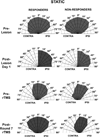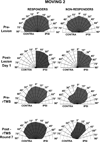Benefit of multiple sessions of perilesional repetitive transcranial magnetic stimulation for an effective rehabilitation of visuospatial function
- PMID: 23167832
- PMCID: PMC3563873
- DOI: 10.1111/ejn.12055
Benefit of multiple sessions of perilesional repetitive transcranial magnetic stimulation for an effective rehabilitation of visuospatial function
Abstract
Noninvasive neurostimulation techniques have been used alone or in conjunction with rehabilitation therapy to treat the neurological sequelae of brain damage with rather variable therapeutic outcomes. One potential factor limiting a consistent success for such techniques may be the limited number of sessions carried out in patients, despite reports that their accrual may play a key role in alleviating neurological deficits long-term. In this study, we tested the effects of seventy consecutive sessions of perilesional high-frequency (10 Hz) repetitive transcranial magnetic stimulation (rTMS) in the treatment of chronic neglect deficits in a well-established feline model of visuospatial neglect. Under identical rTMS parameters and visuospatial testing regimes, half of the subjects improved in visuospatial orienting performance. The other half experienced either none or extremely moderate ameliorations in the neglected hemispace and displayed transient patterns of maladaptive visuospatial behavior. Detailed analyses suggest that lesion location and extent did not account for the behavioral differences observed between these two groups of animals. We conclude that multi-session perilesional rTMS regimes have the potential to induce functional ameliorations following focal chronic brain injury, and that behavioral performance prior to the onset of the rTMS treatment is the factor that best predicts positive outcomes for noninvasive neurostimulation treatments in visuospatial neglect.
© 2012 Federation of European Neuroscience Societies and Blackwell Publishing Ltd.
Figures
References
-
- Abbott LF, Nelson SB. Synaptic plasticity: taming the beast. Nat Neurosci. 2000;3:1178–1183. - PubMed
-
- Amassian VE, Quirk GJ, Stewart M. A comparison of corticospinal activation by magnetic coil and electrical stimulation of monkey motor cortex. Electroencephalogr. Clin. Neurophysiol. 1990;77:390–401. - PubMed
-
- Avenanti A, Coccia M, Ladavas E, Provinciali L, Ceravolo MG. Low-frequency rTMS promotes use-dependent motor plasticity in chronic stroke: a randomized trial. Neurology. 2012;78:256–264. - PubMed
-
- Bäumer T, Lange R, Liepert J, Weiller C, Siebner HR, Rothwell JC, Munchau A. Repeated premotor rTMS leads to cumulative plastic changes of motor cortex excitability in humans. Neuroimage. 2003;1:550–560. - PubMed
Publication types
MeSH terms
Grants and funding
LinkOut - more resources
Full Text Sources









